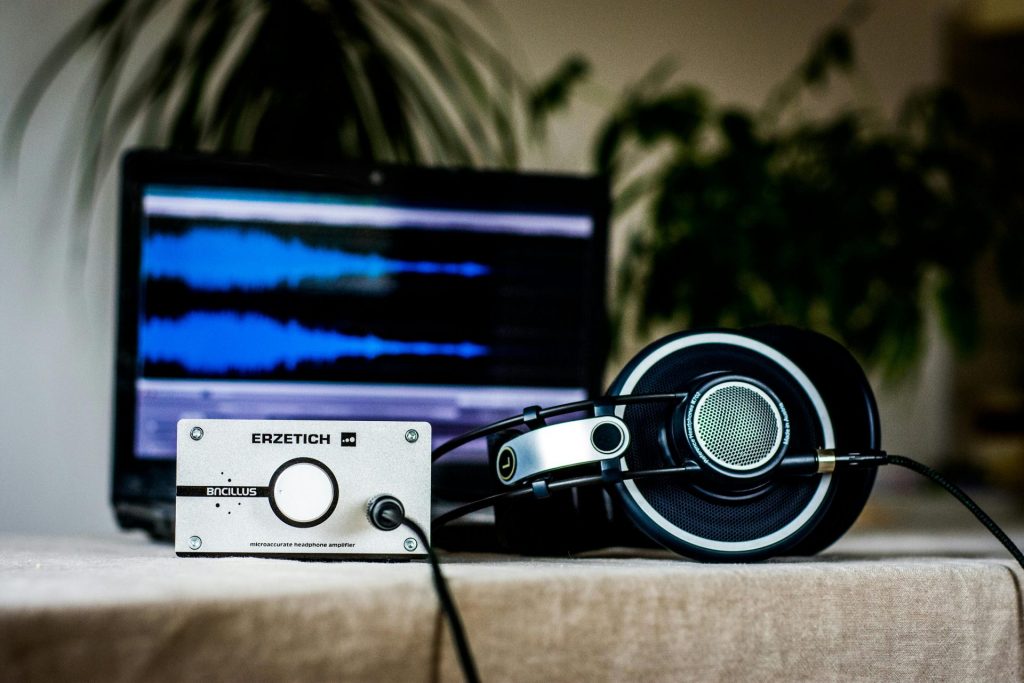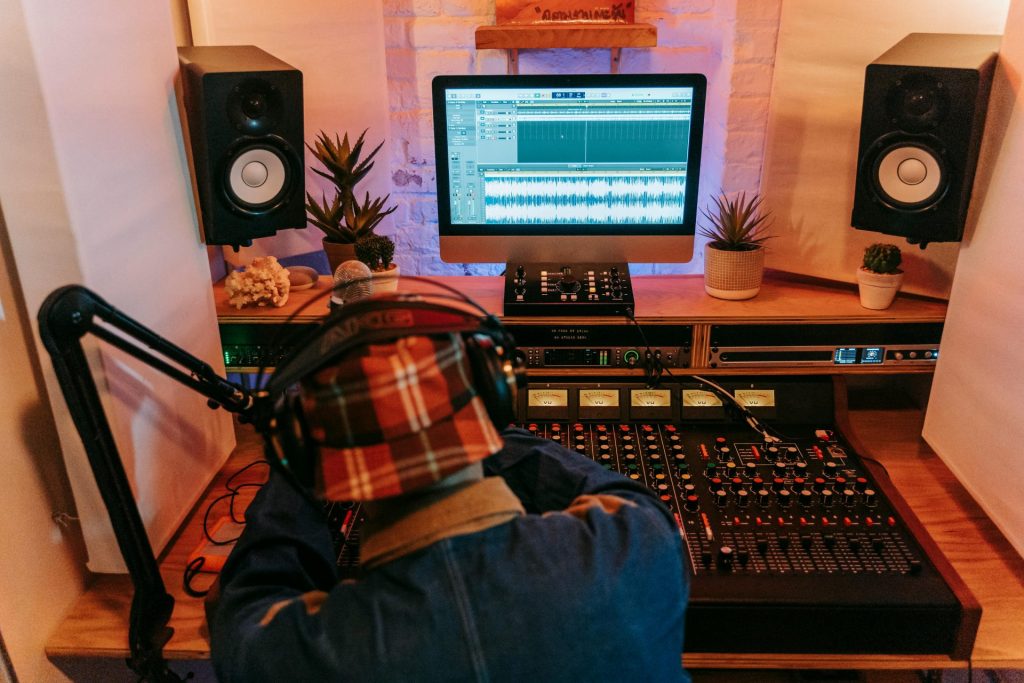
2024 is the year you start making music – no excuses. It’s easy to get caught up in the endless gear guides and audio influencers showcasing the latest and greatest equipment, but the truth is that you only need a handful of tools to start building beats.
Below, we’ll showcase the essential tools you need to start making music. With each category, we’ll share an ideal and budget pick so that you can get into the groove at any price point.

8 Essential Tools to Start Making Music
Each of these eight elements plays a critical role in the music production process. Your gear collection can always be expanded, but start with these pieces as a foundation for building beats. Each gear category is paired with general suggestions, primarily with newer producers in mind, but you can always curate your selections depending on your needs as a musician.
Computer, Phone, or Hardware Controller
We are lucky to have an abundance of options these days when it comes to making music. While using a desktop computer or laptop is the most popular choice for music production, it’s not the only route. You can use your phone or tablet or opt for all-in-one hardware beatmaking tools for a more contained experience.
Pro Tip: Fortunately, there are plenty of desktop computers and laptops available (as well as standalone controllers) that can support a proper music production workflow. When picking out the best system for your needs, you’ll want to prioritize CPU processing power and RAM as the top considerations.
Recommended Gear: 14-inch Macbook Pro with M3 Chip: $1599
Best Buy On a Budget: HP Pavillion 15.6-inch: $629.99
Hardware Piece: AKAI Professional MPC One: $699
DAW
Your DAW or digital audio workstation is where you can record, edit, and produce audio within your computer or other device. All DAWs work in similar ways, though some may be geared to certain genres or styles than others. For example, FL Studio tends to be geared towards electronic music, and Ableton Live (as you might have guessed) is optimized for live performance and ease of recording on the fly.
Pro Tip: Producers certainly like to pick favorites, but all digital audio workstations can accomplish the goal of making music. Use the free trial periods of several DAWs and stick to the workflow that makes the most sense for your needs. However, keep in mind that if you intend on working in a professional studio environment in the future, it’s typically expected that you know AVID’s ProTools, though the standard can vary from one recording space to the next.
Recommended Gear: ProTools Studio: $29.99 per month
Best Buy On a Budget: Logic Pro X: $199 (only available to Mac users)
Interface
You can think of the interface as the bridge between your computer and your microphone and live instruments. An interface seamlessly converts analog sound to digital audio so that you can effectively manipulate it within your digital audio workstation.
Pro Tip: It’s a good idea to invest in an interface that has built-in Phantom Power, a power source used to power studio condenser microphones.
Recommended Gear: Apollo Twin X Duo: $999
Best Buy On a Budget: Scarlett 4i4: $199
Microphone
In most scenarios, you’ll want to opt for a condenser microphone for studio recording. This microphone type is known for its clarity and natural brightness. Don’t forget to pick up a couple of XLR cables so that you can effectively connect your microphone to your interface and record directly into your DAW.
Pro Tip: A condenser microphone will likely be your primary choice for recording vocals. However, it’s wise to have other types of microphones around to capture different styles of music, instruments, and potentially vocalists. Start with a condenser microphone and expand as needed to capture different textures.
Recommended Gear: Neumann TLM 103: $1195
Best Buy On a Budget: AT4040: $299

MIDI Controller
A MIDI controller is a very flexible piece of equipment that allows you to play virtual instruments and samples with ease. Many controllers also have built-in knobs and touchpads that can be programmed to trigger effects, automate sounds, and even assist in live performance.
Pro Tip: If you plan on producing on-the-go often, opt for a 25-key or compact MIDI controller. Many of these controllers can be easily slipped into a backpack or carrying case for mobile beatmaking. While longer MIDI controllers can be efficient for playing parts across all octaves, compact MIDI controllers typically have a button that allows you to shift the position of the keys up or down accordingly.
Recommended Gear: Alesis V49 MKII: $149
Best Buy On a Budget: AKAI Professional MPK Mini MK3: $99
Sample Library
Having access to quality samples will help your beats cut through the noise, and keep your sound fresh instead of relying on the same stock samples provided by your DAW. BPM Create’s extensive library is full of samples, loops, and 1M+ sounds to keep you busy. Our platform also provides MIDI packs and synth presets that you can mix and match with your favorite tracks.
Pro Tip: Many flock to sample libraries when they’re looking to fulfill a specific piece of a puzzle, like finding a punchy snare in an already existing beat. Don’t forget that sample libraries can also operate as excellent sources of inspiration – start off your beat with an inspiring sample and create from there.
Recommended Gear: BPM Create’s Premium Plus Plan: $14.99 per month
Best Buy On a Budget: BPM Create’s Standard Plan: $4.99 per month
Studio Headphones
Studio headphones are different from consumer-grade headphones in that they’re built to provide the most accurate frequency response as possible. Headphones built for casual listening often have certain frequencies boosted like those within the bass region, so they aren’t an ideal choice for getting an accurate depiction of your live session.
Pro Tip: Bluetooth headphones and AirPods might be your choice pick for everyday listening, but skip these options when it comes to studio recording – however minimal, Bluetooth can introduce unnecessary latency, which can create a noticeable delay in your DAW.
Recommended Gear: Beyerdynamic Dt 990 Headphones: $169
Best Buy On a Budget: Audio Technica M20X: $49
Studio Monitors
Studio monitors are particularly pertinent for stereo mixing, as you can get a true sense of effects like panning and the general placement of tracks across the stereo field. Even if you have proper headphones, you’ll want to check your mix on your monitors to tease out any overlooked details. Plus, any mix should be tested within multiple environments to ensure the best listening experience across the board.
Pro Tip: Your studio monitors must be set up so that you are perfectly triangulated between the left and right monitors. Proper studio monitor setup entails that your monitors are angled slightly towards you, equidistant apart at about a 60-degree angle as shown here.
Recommended Gear: iLoud Precision Monitors with Built-in Calibration: $899
Best Buy On a Budget: Yamaha HS4 Pair: $249

So You’ve Got the Gear…Now What?
Having the right tools to make music is vital, but your beats are only as good as the time you’re willing to put into them. Use these tips to ensure your new gear doesn’t become a fancy dust collector:
Get Inspired: Tools like the BPM Music blog are full of inspiration, tips, and tricks designed to get you back into your DAW. You can also use YouTube tutorials to learn how to make music in any genre or walkthrough putting together your new setup.
Keep Yourself Accountable: There will be times when you feel spontaneously compelled to make music….and many times when you don’t. If you’re serious about putting your gear to good use, set actionable goals around your process. For instance, you could challenge yourself to create a demo from start to finish within a month. You don’t have to distribute the music you make as a result of these challenges, but in any case, this is a surefire way to consistently build your skill set.
Invite People Into Your Process: Bringing in vocalists, other beat makers, and instrumentalists can be an excellent learning experience that will likely produce some bangers in the process. Get involved in your local music community and don’t be afraid to ask others for feedback on your work.
Rinse and Repeat: As with any skill, you have to put in your hours with music production to take your art to new heights. Get in the habit of making music regularly, and before you know it, you’ll be blown away by your creations.

